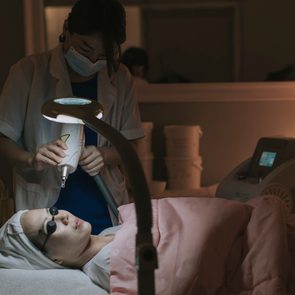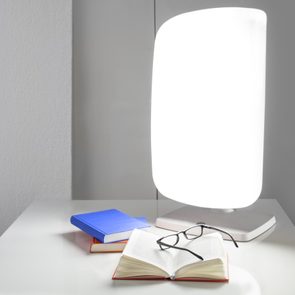What Does Green Light Therapy Do? Here’s What to Know
Updated: Jun. 03, 2021
Green light therapy may help with pain management related to migraine, fibromyalgia, and other chronic pain conditions. Here's what to know.
What is green light therapy?
Green light therapy—a band of green light from a specific lamp—may one day be used to help mitigate pain in conditions like migraine or fibromyalgia.
That could be helpful because pain medications like opioids come with side effects, not to mention potential dependence and addiction. Plus, they don’t fully relieve pain. (Here’s how to get natural pain relief.)
Green light may be offered as a complementary treatment to reduce the need for prescription pain medications or finally help you get a handle on your pain, and improve your everyday functioning and quality of life in the process.
For example, have you ever noticed the calming effect being out in nature—particularly among greenery—has on your sense of wellbeing? Mohab M. Ibrahim, MD, director of the Chronic Pain Management Clinic at the University of Arizona College of Medicine in Tucson, has. “My older brother gets occasional headaches, and he would tell me that he would feel better just sitting in his backyard, which had a lot of trees.”
Taking a cue from his brother, Dr. Ibrahim would seek out greenery in a park when he experienced headaches. And, like his brother, he felt relief from the pain.
“I started asking myself why my headache got better,” Dr. Ibrahim says. Maybe it was the quiet of the park or the trees themselves were releasing a chemical. But studying the chemicals in the air would have been a gargantuan task, so he aimed for lower hanging fruit. Maybe, he thought, it’s the green color.
Later, in a series of animal experiments, Dr. Ibrahim’s lab showed that exposing rats to green light seemed to decrease their levels of acute and chronic pain, per research in the journal Pain in 2017. He then went on to conduct clinical experiments in humans with pain conditions.

What the science says
Green light therapy and migraine
In a small study, published in 2020 in Cephalalgia, Dr. Ibrahim and a team of researchers enlisted 29 patients with episodic or chronic migraine and exposed them to white light for one to two hours daily for 10 weeks. After a two-week break, the participants were then exposed to green light for one to two hours daily for 10 weeks. They were allowed to continue with whatever migraine treatment had been previously prescribed by their doctor. Participants were given these light diodes to use at home.
The researchers found that white light did reduce headaches, from 18.2 headache days per month to 16.5. However, exposure to green light seemed more effective. During the therapy, episodic migraines decreased from 7.9 to 2.4 headache days per month and chronic migraines from 22.3 to 9.4 headache days per month.
The green light therapy also seemed to reduce headache intensity and duration, as well as improve quality of life (such as better sleep and daytime functioning).
“At the end of the study, most patients did not want to return the green light,” says Dr. Ibrahim. “We took it as indication of their happiness with the therapy.”
(Try these migraine remedies proven to work.)
Green light therapy, fibromyalgia, and other pain-related conditions
It’s not just migraine, but chronic pain conditions that may be helped by green light therapy. For example, green light was shown to have a positive effect on pain from fibromyalgia—a condition marked by widespread pain, sleep problems, and fatigue.
In another study by Dr. Ibrahim, published in Pain Medicine in 2020, 21 adults with fibromyalgia were exposed to white light for one to two hours daily for 10 weeks, followed by green light therapy. During the green light exposure, patients reported a reduction in pain intensity.
(Here are some natural fibromyalgia treatments to try.)
Why green light therapy may work
As of now, scientists aren’t sure why green light might dial down pain. But they have some theories.
“The main reason we think green light plays a role is because color stimulates the visual cortex in ways that can alter perceptions of pain,” says Padma Gulur, MD, director of pain management strategy and opioid surveillance at Duke University Health System in Durham, North Carolina, who also studies the role of wearable green light in pain.
Different colors have different effects. Blue and clear light tend to trigger headaches, says Dr. Gulur, while green is perceived as more pleasant and calming. In her research, many participants also wanted to keep their green light wearable devices at the study’s end.
So far, she’s seen promising results with green light therapy in fibromyalgia and is now studying diabetic neuropathy, which is diabetes-related nerve damage, and headaches.
(Here’s how laser and light therapy may help rosacea.)
Buying and using green light at home
Green light is easy to purchase for your home, as there are numerous green LED light strips available at places like Amazon. The Allay Lamp, which was developed by a team of researchers led by Rami Burstein, PhD, a professor of neuroscience at Harvard Medical School, is a green bulb lamp designed for migraine reduction.
While some green light products are legitimate and effective, you do have to be careful about what you’re buying as there are no Food and Drug Administration-regulated products on the market, notes Dr. Ibrahim.
Since the research is preliminary, the optimal dose and timing of light isn’t yet known. And there may be different guidelines for maintaining or controlling the condition after initial treatment.
However, there is something you can do without buying a light at all: Go outside. “I recommend spending time in green environments to see if it has an impact on your pain,” says Dr. Gulur. Taking a walk in a natural environment also provides exercise and has a revitalizing effect on your mood. You might also consider bringing more green plants into your home, she says.
(Got seasonal depression? These are the best light therapy lamps to buy on Amazon.)
Side effects of green light therapy
In Dr. Ibrahim’s research, no participants reported side effects. But that doesn’t mean green light therapy is risk-free.
“If you want to try it, I strongly advise talking with a physician first,” he says. If you have an eye condition, ask your doctor if LED therapy might be harmful for your eye health.
Also important, green LED therapy is intended to be a complementary therapy—not as a medication replacement. Don’t stop your current treatment in order to try green light therapy and speak to your doctor about trying it. (Find out what happened when a woman used light box therapy for seasonal depression.)
The last word
The research on green light therapy for migraine, fibromyalgia, and other chronic pain conditions is promising, but limited. Yes, you can opt to buy a green light online.
But remember: Since there’s not enough research to support its claims, there’s no official guideline for how and what to look for in a green light lamp. You should always talk with your doctor first before trying a complementary treatment with your current treatment plan.



















